Analyzing Customer Behavior Impact on Marketing Strategies
VerifiedAdded on 2020/07/22
|10
|2821
|90
Report
AI Summary
This report delves into the significant role of customer behavior in shaping marketing strategies. It begins by defining customer behavior and its impact on marketing activities, followed by an exploration of the research aim, which focuses on analyzing the impact of customer behavior on Tesco PLC's marketing. The report then outlines the objectives, which include exploring the concepts of customer behavior and marketing, analyzing the influencing factors, evaluating buying behaviors, and assessing the impact on Tesco PLC. A comprehensive literature review is provided, covering the concepts of customer behavior, marketing, and the various factors influencing customer decisions. The research methodology section outlines the qualitative research strategy, inductive research approach, interpretivism philosophy, and explanatory research design, along with data collection methods using surveys and thematic data analysis. The report concludes with a time scale of the research activities.

RESEARCH PROJECT
Paraphrase This Document
Need a fresh take? Get an instant paraphrase of this document with our AI Paraphraser
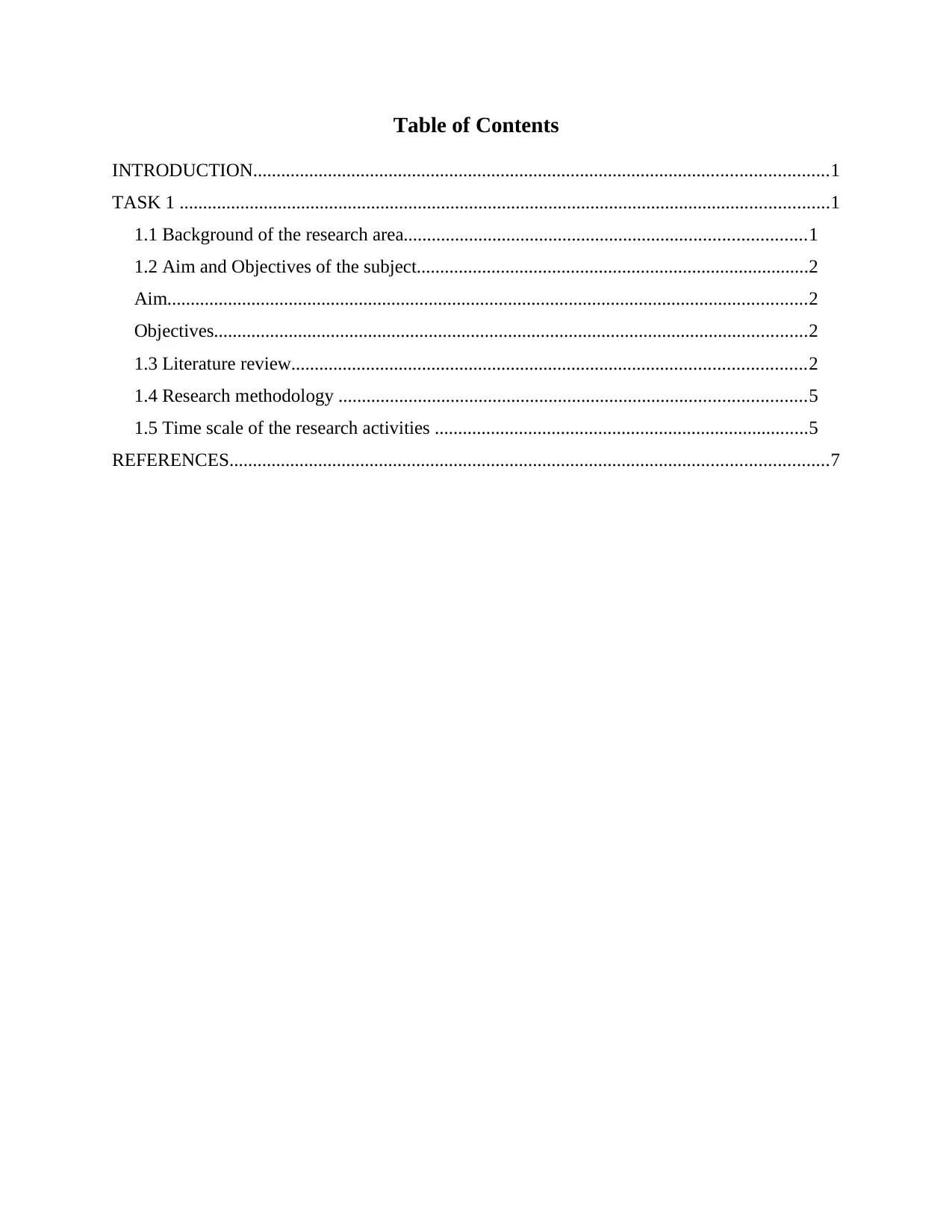
Table of Contents
INTRODUCTION...........................................................................................................................1
TASK 1 ...........................................................................................................................................1
1.1 Background of the research area......................................................................................1
1.2 Aim and Objectives of the subject....................................................................................2
Aim.........................................................................................................................................2
Objectives...............................................................................................................................2
1.3 Literature review..............................................................................................................2
1.4 Research methodology ....................................................................................................5
1.5 Time scale of the research activities ................................................................................5
REFERENCES................................................................................................................................7
INTRODUCTION...........................................................................................................................1
TASK 1 ...........................................................................................................................................1
1.1 Background of the research area......................................................................................1
1.2 Aim and Objectives of the subject....................................................................................2
Aim.........................................................................................................................................2
Objectives...............................................................................................................................2
1.3 Literature review..............................................................................................................2
1.4 Research methodology ....................................................................................................5
1.5 Time scale of the research activities ................................................................................5
REFERENCES................................................................................................................................7
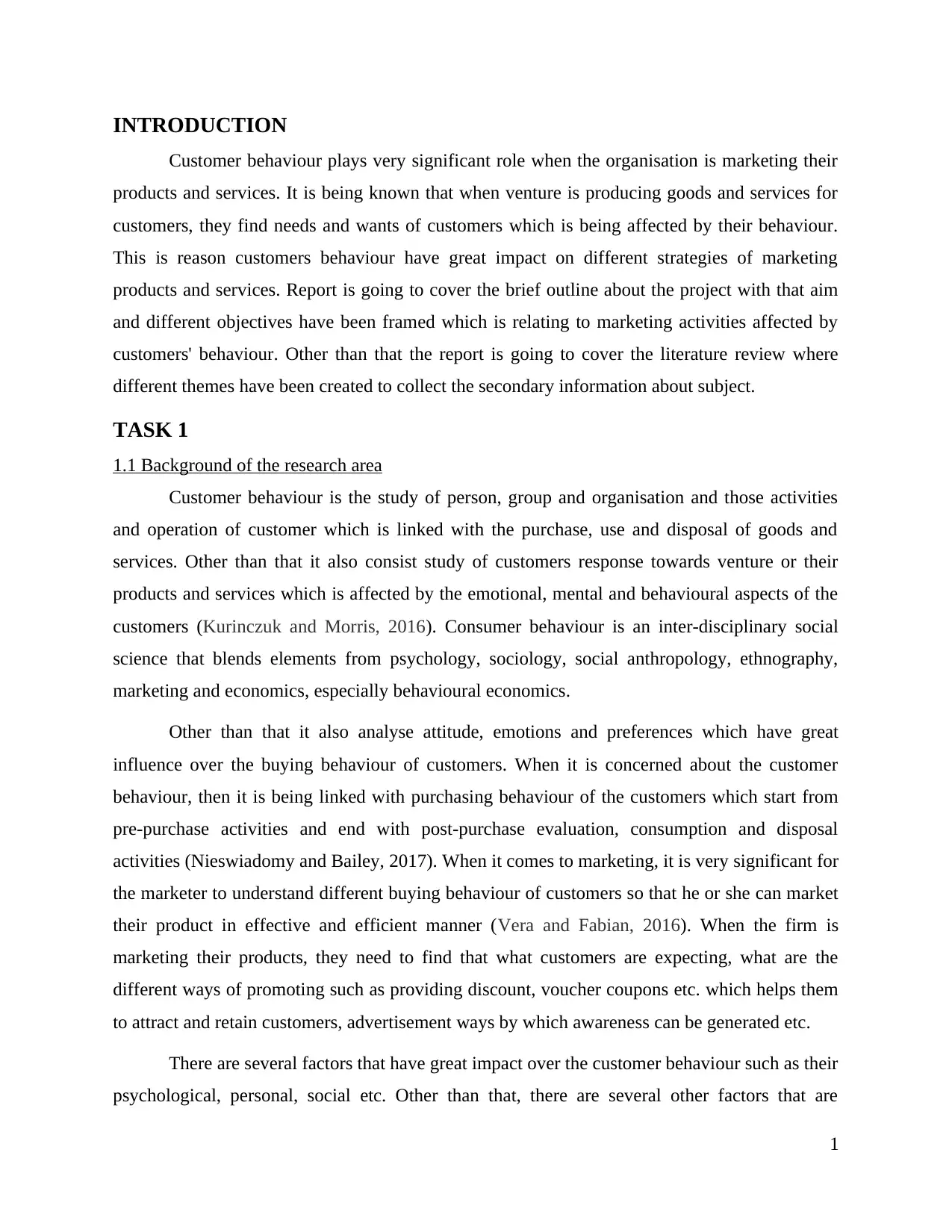
INTRODUCTION
Customer behaviour plays very significant role when the organisation is marketing their
products and services. It is being known that when venture is producing goods and services for
customers, they find needs and wants of customers which is being affected by their behaviour.
This is reason customers behaviour have great impact on different strategies of marketing
products and services. Report is going to cover the brief outline about the project with that aim
and different objectives have been framed which is relating to marketing activities affected by
customers' behaviour. Other than that the report is going to cover the literature review where
different themes have been created to collect the secondary information about subject.
TASK 1
1.1 Background of the research area
Customer behaviour is the study of person, group and organisation and those activities
and operation of customer which is linked with the purchase, use and disposal of goods and
services. Other than that it also consist study of customers response towards venture or their
products and services which is affected by the emotional, mental and behavioural aspects of the
customers (Kurinczuk and Morris, 2016). Consumer behaviour is an inter-disciplinary social
science that blends elements from psychology, sociology, social anthropology, ethnography,
marketing and economics, especially behavioural economics.
Other than that it also analyse attitude, emotions and preferences which have great
influence over the buying behaviour of customers. When it is concerned about the customer
behaviour, then it is being linked with purchasing behaviour of the customers which start from
pre-purchase activities and end with post-purchase evaluation, consumption and disposal
activities (Nieswiadomy and Bailey, 2017). When it comes to marketing, it is very significant for
the marketer to understand different buying behaviour of customers so that he or she can market
their product in effective and efficient manner (Vera and Fabian, 2016). When the firm is
marketing their products, they need to find that what customers are expecting, what are the
different ways of promoting such as providing discount, voucher coupons etc. which helps them
to attract and retain customers, advertisement ways by which awareness can be generated etc.
There are several factors that have great impact over the customer behaviour such as their
psychological, personal, social etc. Other than that, there are several other factors that are
1
Customer behaviour plays very significant role when the organisation is marketing their
products and services. It is being known that when venture is producing goods and services for
customers, they find needs and wants of customers which is being affected by their behaviour.
This is reason customers behaviour have great impact on different strategies of marketing
products and services. Report is going to cover the brief outline about the project with that aim
and different objectives have been framed which is relating to marketing activities affected by
customers' behaviour. Other than that the report is going to cover the literature review where
different themes have been created to collect the secondary information about subject.
TASK 1
1.1 Background of the research area
Customer behaviour is the study of person, group and organisation and those activities
and operation of customer which is linked with the purchase, use and disposal of goods and
services. Other than that it also consist study of customers response towards venture or their
products and services which is affected by the emotional, mental and behavioural aspects of the
customers (Kurinczuk and Morris, 2016). Consumer behaviour is an inter-disciplinary social
science that blends elements from psychology, sociology, social anthropology, ethnography,
marketing and economics, especially behavioural economics.
Other than that it also analyse attitude, emotions and preferences which have great
influence over the buying behaviour of customers. When it is concerned about the customer
behaviour, then it is being linked with purchasing behaviour of the customers which start from
pre-purchase activities and end with post-purchase evaluation, consumption and disposal
activities (Nieswiadomy and Bailey, 2017). When it comes to marketing, it is very significant for
the marketer to understand different buying behaviour of customers so that he or she can market
their product in effective and efficient manner (Vera and Fabian, 2016). When the firm is
marketing their products, they need to find that what customers are expecting, what are the
different ways of promoting such as providing discount, voucher coupons etc. which helps them
to attract and retain customers, advertisement ways by which awareness can be generated etc.
There are several factors that have great impact over the customer behaviour such as their
psychological, personal, social etc. Other than that, there are several other factors that are
1
⊘ This is a preview!⊘
Do you want full access?
Subscribe today to unlock all pages.

Trusted by 1+ million students worldwide
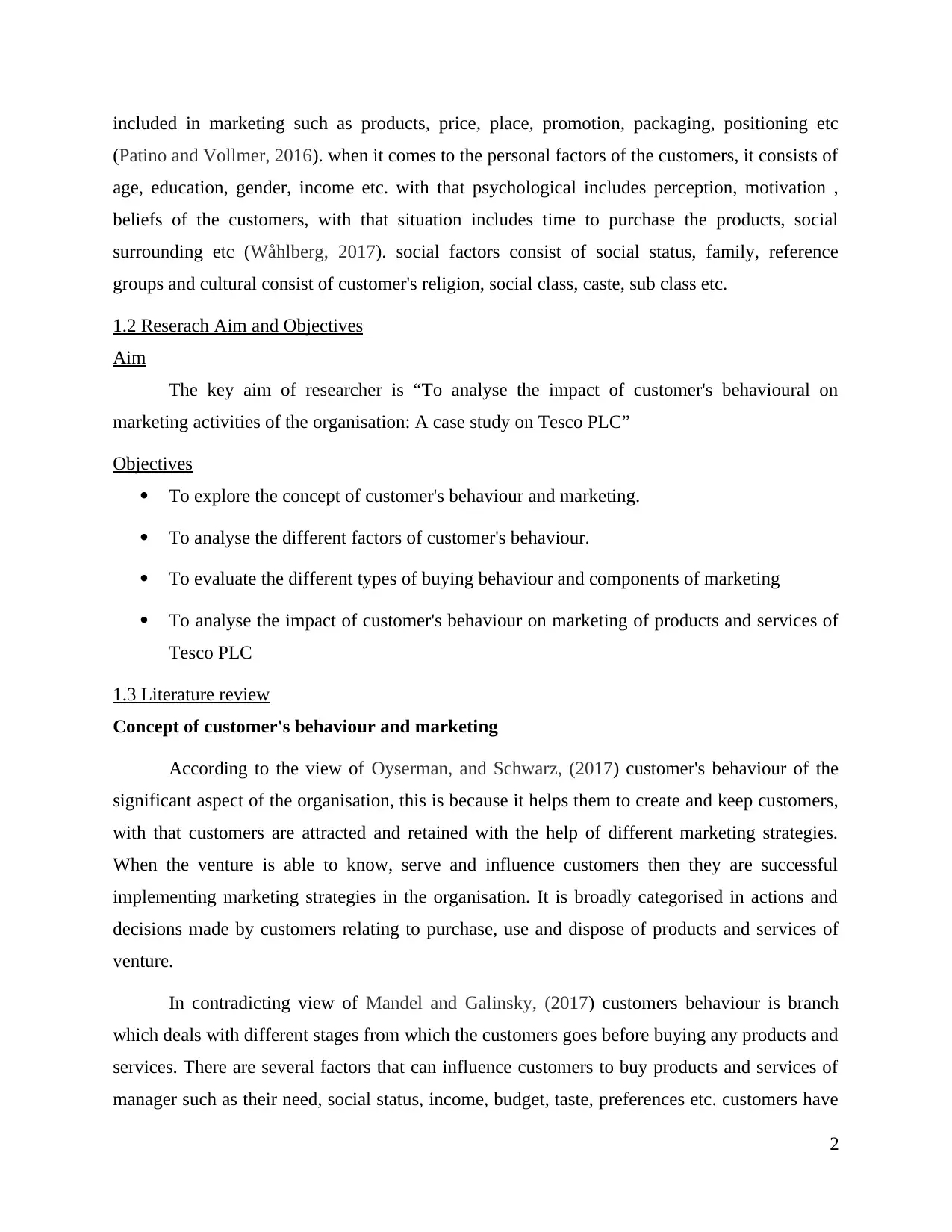
included in marketing such as products, price, place, promotion, packaging, positioning etc
(Patino and Vollmer, 2016). when it comes to the personal factors of the customers, it consists of
age, education, gender, income etc. with that psychological includes perception, motivation ,
beliefs of the customers, with that situation includes time to purchase the products, social
surrounding etc (Wåhlberg, 2017). social factors consist of social status, family, reference
groups and cultural consist of customer's religion, social class, caste, sub class etc.
1.2 Reserach Aim and Objectives
Aim
The key aim of researcher is “To analyse the impact of customer's behavioural on
marketing activities of the organisation: A case study on Tesco PLC”
Objectives
To explore the concept of customer's behaviour and marketing.
To analyse the different factors of customer's behaviour.
To evaluate the different types of buying behaviour and components of marketing
To analyse the impact of customer's behaviour on marketing of products and services of
Tesco PLC
1.3 Literature review
Concept of customer's behaviour and marketing
According to the view of Oyserman, and Schwarz, (2017) customer's behaviour of the
significant aspect of the organisation, this is because it helps them to create and keep customers,
with that customers are attracted and retained with the help of different marketing strategies.
When the venture is able to know, serve and influence customers then they are successful
implementing marketing strategies in the organisation. It is broadly categorised in actions and
decisions made by customers relating to purchase, use and dispose of products and services of
venture.
In contradicting view of Mandel and Galinsky, (2017) customers behaviour is branch
which deals with different stages from which the customers goes before buying any products and
services. There are several factors that can influence customers to buy products and services of
manager such as their need, social status, income, budget, taste, preferences etc. customers have
2
(Patino and Vollmer, 2016). when it comes to the personal factors of the customers, it consists of
age, education, gender, income etc. with that psychological includes perception, motivation ,
beliefs of the customers, with that situation includes time to purchase the products, social
surrounding etc (Wåhlberg, 2017). social factors consist of social status, family, reference
groups and cultural consist of customer's religion, social class, caste, sub class etc.
1.2 Reserach Aim and Objectives
Aim
The key aim of researcher is “To analyse the impact of customer's behavioural on
marketing activities of the organisation: A case study on Tesco PLC”
Objectives
To explore the concept of customer's behaviour and marketing.
To analyse the different factors of customer's behaviour.
To evaluate the different types of buying behaviour and components of marketing
To analyse the impact of customer's behaviour on marketing of products and services of
Tesco PLC
1.3 Literature review
Concept of customer's behaviour and marketing
According to the view of Oyserman, and Schwarz, (2017) customer's behaviour of the
significant aspect of the organisation, this is because it helps them to create and keep customers,
with that customers are attracted and retained with the help of different marketing strategies.
When the venture is able to know, serve and influence customers then they are successful
implementing marketing strategies in the organisation. It is broadly categorised in actions and
decisions made by customers relating to purchase, use and dispose of products and services of
venture.
In contradicting view of Mandel and Galinsky, (2017) customers behaviour is branch
which deals with different stages from which the customers goes before buying any products and
services. There are several factors that can influence customers to buy products and services of
manager such as their need, social status, income, budget, taste, preferences etc. customers have
2
Paraphrase This Document
Need a fresh take? Get an instant paraphrase of this document with our AI Paraphraser
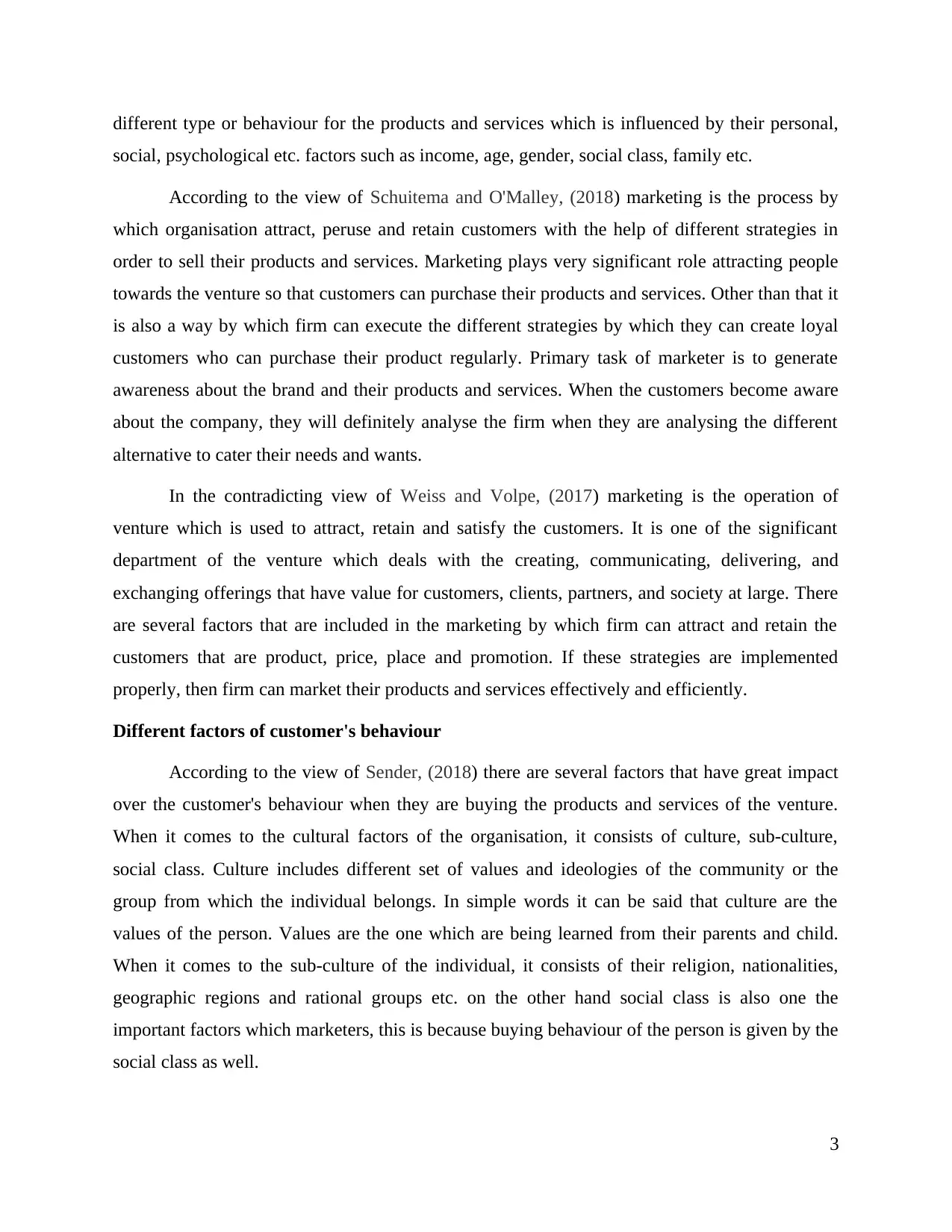
different type or behaviour for the products and services which is influenced by their personal,
social, psychological etc. factors such as income, age, gender, social class, family etc.
According to the view of Schuitema and O'Malley, (2018) marketing is the process by
which organisation attract, peruse and retain customers with the help of different strategies in
order to sell their products and services. Marketing plays very significant role attracting people
towards the venture so that customers can purchase their products and services. Other than that it
is also a way by which firm can execute the different strategies by which they can create loyal
customers who can purchase their product regularly. Primary task of marketer is to generate
awareness about the brand and their products and services. When the customers become aware
about the company, they will definitely analyse the firm when they are analysing the different
alternative to cater their needs and wants.
In the contradicting view of Weiss and Volpe, (2017) marketing is the operation of
venture which is used to attract, retain and satisfy the customers. It is one of the significant
department of the venture which deals with the creating, communicating, delivering, and
exchanging offerings that have value for customers, clients, partners, and society at large. There
are several factors that are included in the marketing by which firm can attract and retain the
customers that are product, price, place and promotion. If these strategies are implemented
properly, then firm can market their products and services effectively and efficiently.
Different factors of customer's behaviour
According to the view of Sender, (2018) there are several factors that have great impact
over the customer's behaviour when they are buying the products and services of the venture.
When it comes to the cultural factors of the organisation, it consists of culture, sub-culture,
social class. Culture includes different set of values and ideologies of the community or the
group from which the individual belongs. In simple words it can be said that culture are the
values of the person. Values are the one which are being learned from their parents and child.
When it comes to the sub-culture of the individual, it consists of their religion, nationalities,
geographic regions and rational groups etc. on the other hand social class is also one the
important factors which marketers, this is because buying behaviour of the person is given by the
social class as well.
3
social, psychological etc. factors such as income, age, gender, social class, family etc.
According to the view of Schuitema and O'Malley, (2018) marketing is the process by
which organisation attract, peruse and retain customers with the help of different strategies in
order to sell their products and services. Marketing plays very significant role attracting people
towards the venture so that customers can purchase their products and services. Other than that it
is also a way by which firm can execute the different strategies by which they can create loyal
customers who can purchase their product regularly. Primary task of marketer is to generate
awareness about the brand and their products and services. When the customers become aware
about the company, they will definitely analyse the firm when they are analysing the different
alternative to cater their needs and wants.
In the contradicting view of Weiss and Volpe, (2017) marketing is the operation of
venture which is used to attract, retain and satisfy the customers. It is one of the significant
department of the venture which deals with the creating, communicating, delivering, and
exchanging offerings that have value for customers, clients, partners, and society at large. There
are several factors that are included in the marketing by which firm can attract and retain the
customers that are product, price, place and promotion. If these strategies are implemented
properly, then firm can market their products and services effectively and efficiently.
Different factors of customer's behaviour
According to the view of Sender, (2018) there are several factors that have great impact
over the customer's behaviour when they are buying the products and services of the venture.
When it comes to the cultural factors of the organisation, it consists of culture, sub-culture,
social class. Culture includes different set of values and ideologies of the community or the
group from which the individual belongs. In simple words it can be said that culture are the
values of the person. Values are the one which are being learned from their parents and child.
When it comes to the sub-culture of the individual, it consists of their religion, nationalities,
geographic regions and rational groups etc. on the other hand social class is also one the
important factors which marketers, this is because buying behaviour of the person is given by the
social class as well.
3
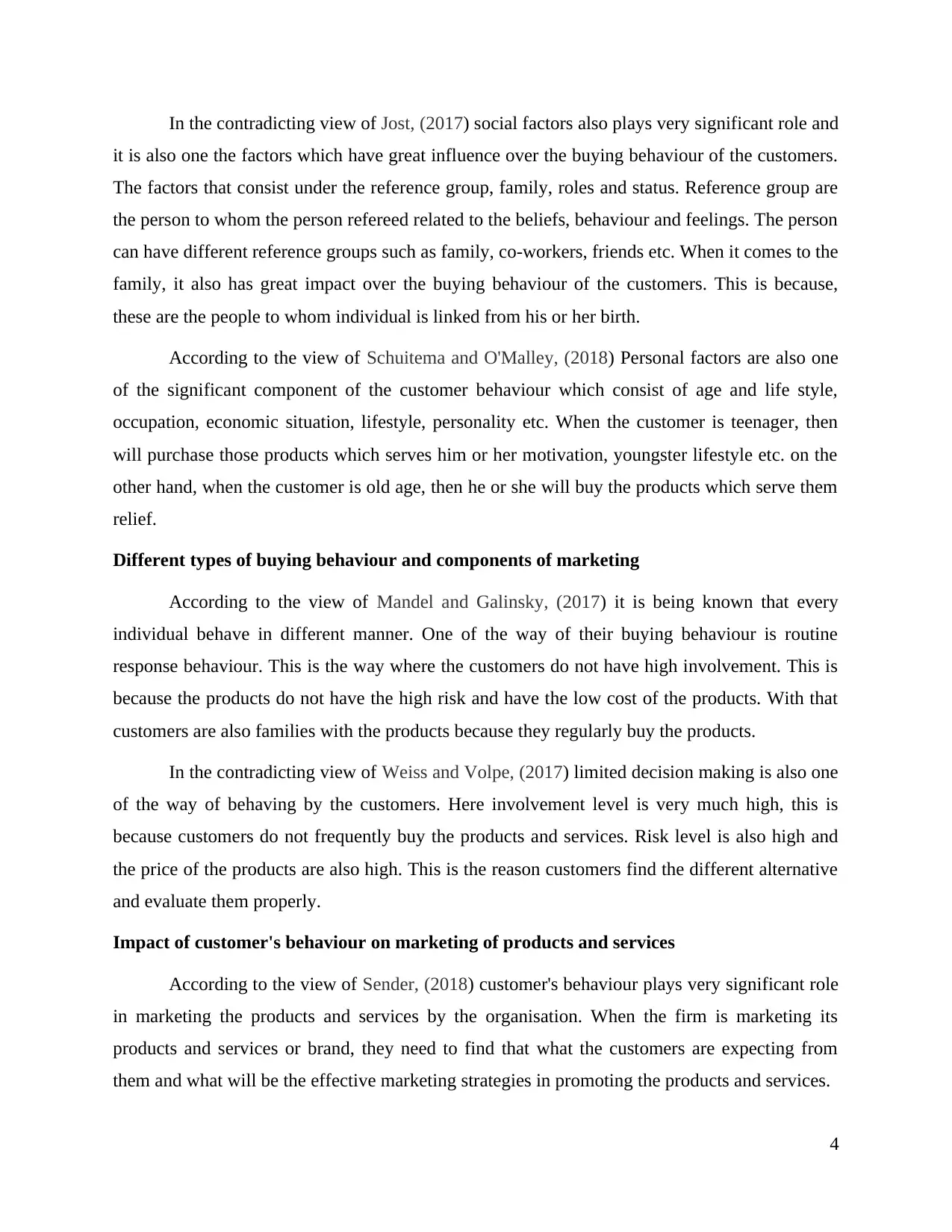
In the contradicting view of Jost, (2017) social factors also plays very significant role and
it is also one the factors which have great influence over the buying behaviour of the customers.
The factors that consist under the reference group, family, roles and status. Reference group are
the person to whom the person refereed related to the beliefs, behaviour and feelings. The person
can have different reference groups such as family, co-workers, friends etc. When it comes to the
family, it also has great impact over the buying behaviour of the customers. This is because,
these are the people to whom individual is linked from his or her birth.
According to the view of Schuitema and O'Malley, (2018) Personal factors are also one
of the significant component of the customer behaviour which consist of age and life style,
occupation, economic situation, lifestyle, personality etc. When the customer is teenager, then
will purchase those products which serves him or her motivation, youngster lifestyle etc. on the
other hand, when the customer is old age, then he or she will buy the products which serve them
relief.
Different types of buying behaviour and components of marketing
According to the view of Mandel and Galinsky, (2017) it is being known that every
individual behave in different manner. One of the way of their buying behaviour is routine
response behaviour. This is the way where the customers do not have high involvement. This is
because the products do not have the high risk and have the low cost of the products. With that
customers are also families with the products because they regularly buy the products.
In the contradicting view of Weiss and Volpe, (2017) limited decision making is also one
of the way of behaving by the customers. Here involvement level is very much high, this is
because customers do not frequently buy the products and services. Risk level is also high and
the price of the products are also high. This is the reason customers find the different alternative
and evaluate them properly.
Impact of customer's behaviour on marketing of products and services
According to the view of Sender, (2018) customer's behaviour plays very significant role
in marketing the products and services by the organisation. When the firm is marketing its
products and services or brand, they need to find that what the customers are expecting from
them and what will be the effective marketing strategies in promoting the products and services.
4
it is also one the factors which have great influence over the buying behaviour of the customers.
The factors that consist under the reference group, family, roles and status. Reference group are
the person to whom the person refereed related to the beliefs, behaviour and feelings. The person
can have different reference groups such as family, co-workers, friends etc. When it comes to the
family, it also has great impact over the buying behaviour of the customers. This is because,
these are the people to whom individual is linked from his or her birth.
According to the view of Schuitema and O'Malley, (2018) Personal factors are also one
of the significant component of the customer behaviour which consist of age and life style,
occupation, economic situation, lifestyle, personality etc. When the customer is teenager, then
will purchase those products which serves him or her motivation, youngster lifestyle etc. on the
other hand, when the customer is old age, then he or she will buy the products which serve them
relief.
Different types of buying behaviour and components of marketing
According to the view of Mandel and Galinsky, (2017) it is being known that every
individual behave in different manner. One of the way of their buying behaviour is routine
response behaviour. This is the way where the customers do not have high involvement. This is
because the products do not have the high risk and have the low cost of the products. With that
customers are also families with the products because they regularly buy the products.
In the contradicting view of Weiss and Volpe, (2017) limited decision making is also one
of the way of behaving by the customers. Here involvement level is very much high, this is
because customers do not frequently buy the products and services. Risk level is also high and
the price of the products are also high. This is the reason customers find the different alternative
and evaluate them properly.
Impact of customer's behaviour on marketing of products and services
According to the view of Sender, (2018) customer's behaviour plays very significant role
in marketing the products and services by the organisation. When the firm is marketing its
products and services or brand, they need to find that what the customers are expecting from
them and what will be the effective marketing strategies in promoting the products and services.
4
⊘ This is a preview!⊘
Do you want full access?
Subscribe today to unlock all pages.

Trusted by 1+ million students worldwide
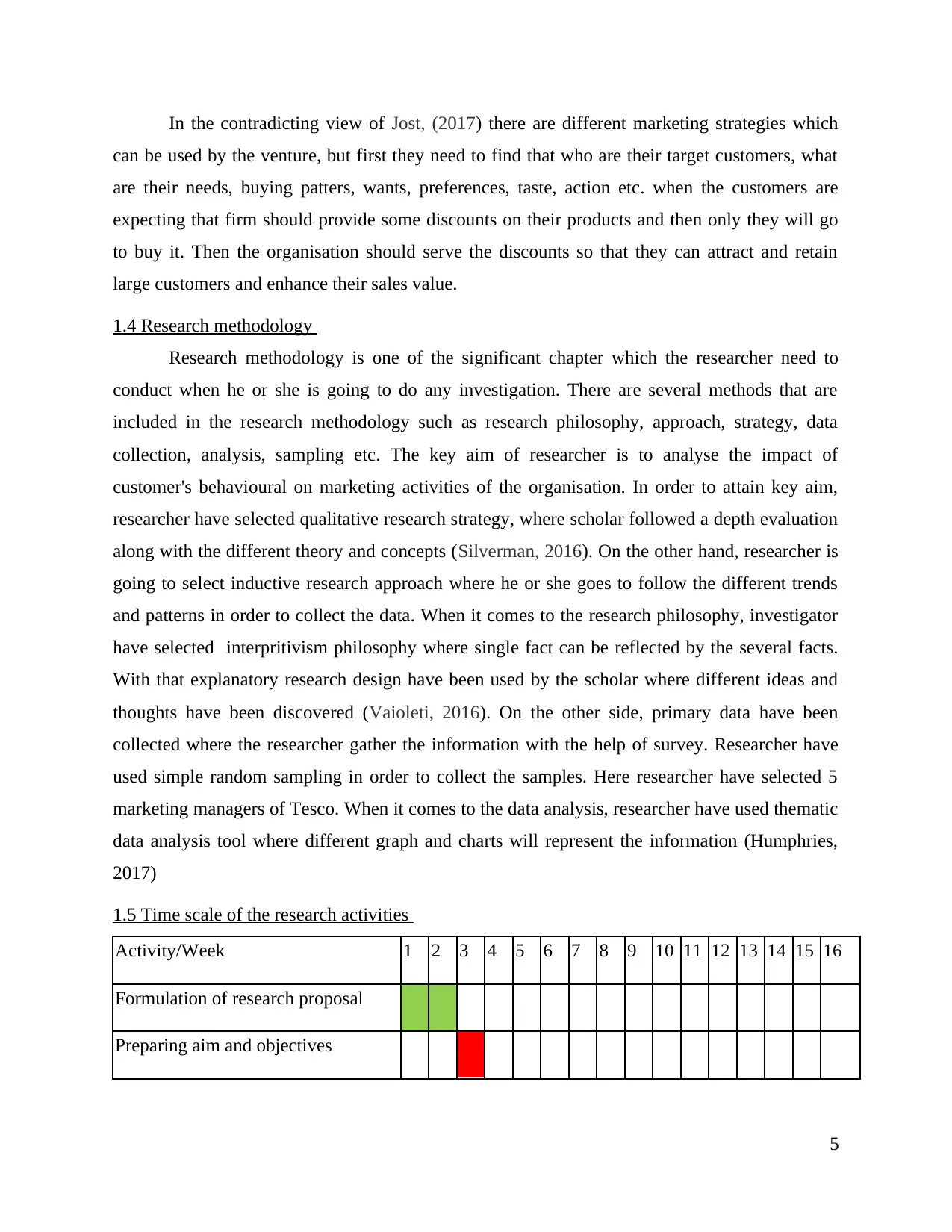
In the contradicting view of Jost, (2017) there are different marketing strategies which
can be used by the venture, but first they need to find that who are their target customers, what
are their needs, buying patters, wants, preferences, taste, action etc. when the customers are
expecting that firm should provide some discounts on their products and then only they will go
to buy it. Then the organisation should serve the discounts so that they can attract and retain
large customers and enhance their sales value.
1.4 Research methodology
Research methodology is one of the significant chapter which the researcher need to
conduct when he or she is going to do any investigation. There are several methods that are
included in the research methodology such as research philosophy, approach, strategy, data
collection, analysis, sampling etc. The key aim of researcher is to analyse the impact of
customer's behavioural on marketing activities of the organisation. In order to attain key aim,
researcher have selected qualitative research strategy, where scholar followed a depth evaluation
along with the different theory and concepts (Silverman, 2016). On the other hand, researcher is
going to select inductive research approach where he or she goes to follow the different trends
and patterns in order to collect the data. When it comes to the research philosophy, investigator
have selected interpritivism philosophy where single fact can be reflected by the several facts.
With that explanatory research design have been used by the scholar where different ideas and
thoughts have been discovered (Vaioleti, 2016). On the other side, primary data have been
collected where the researcher gather the information with the help of survey. Researcher have
used simple random sampling in order to collect the samples. Here researcher have selected 5
marketing managers of Tesco. When it comes to the data analysis, researcher have used thematic
data analysis tool where different graph and charts will represent the information (Humphries,
2017)
1.5 Time scale of the research activities
Activity/Week 1 2 3 4 5 6 7 8 9 10 11 12 13 14 15 16
Formulation of research proposal
Preparing aim and objectives
5
can be used by the venture, but first they need to find that who are their target customers, what
are their needs, buying patters, wants, preferences, taste, action etc. when the customers are
expecting that firm should provide some discounts on their products and then only they will go
to buy it. Then the organisation should serve the discounts so that they can attract and retain
large customers and enhance their sales value.
1.4 Research methodology
Research methodology is one of the significant chapter which the researcher need to
conduct when he or she is going to do any investigation. There are several methods that are
included in the research methodology such as research philosophy, approach, strategy, data
collection, analysis, sampling etc. The key aim of researcher is to analyse the impact of
customer's behavioural on marketing activities of the organisation. In order to attain key aim,
researcher have selected qualitative research strategy, where scholar followed a depth evaluation
along with the different theory and concepts (Silverman, 2016). On the other hand, researcher is
going to select inductive research approach where he or she goes to follow the different trends
and patterns in order to collect the data. When it comes to the research philosophy, investigator
have selected interpritivism philosophy where single fact can be reflected by the several facts.
With that explanatory research design have been used by the scholar where different ideas and
thoughts have been discovered (Vaioleti, 2016). On the other side, primary data have been
collected where the researcher gather the information with the help of survey. Researcher have
used simple random sampling in order to collect the samples. Here researcher have selected 5
marketing managers of Tesco. When it comes to the data analysis, researcher have used thematic
data analysis tool where different graph and charts will represent the information (Humphries,
2017)
1.5 Time scale of the research activities
Activity/Week 1 2 3 4 5 6 7 8 9 10 11 12 13 14 15 16
Formulation of research proposal
Preparing aim and objectives
5
Paraphrase This Document
Need a fresh take? Get an instant paraphrase of this document with our AI Paraphraser
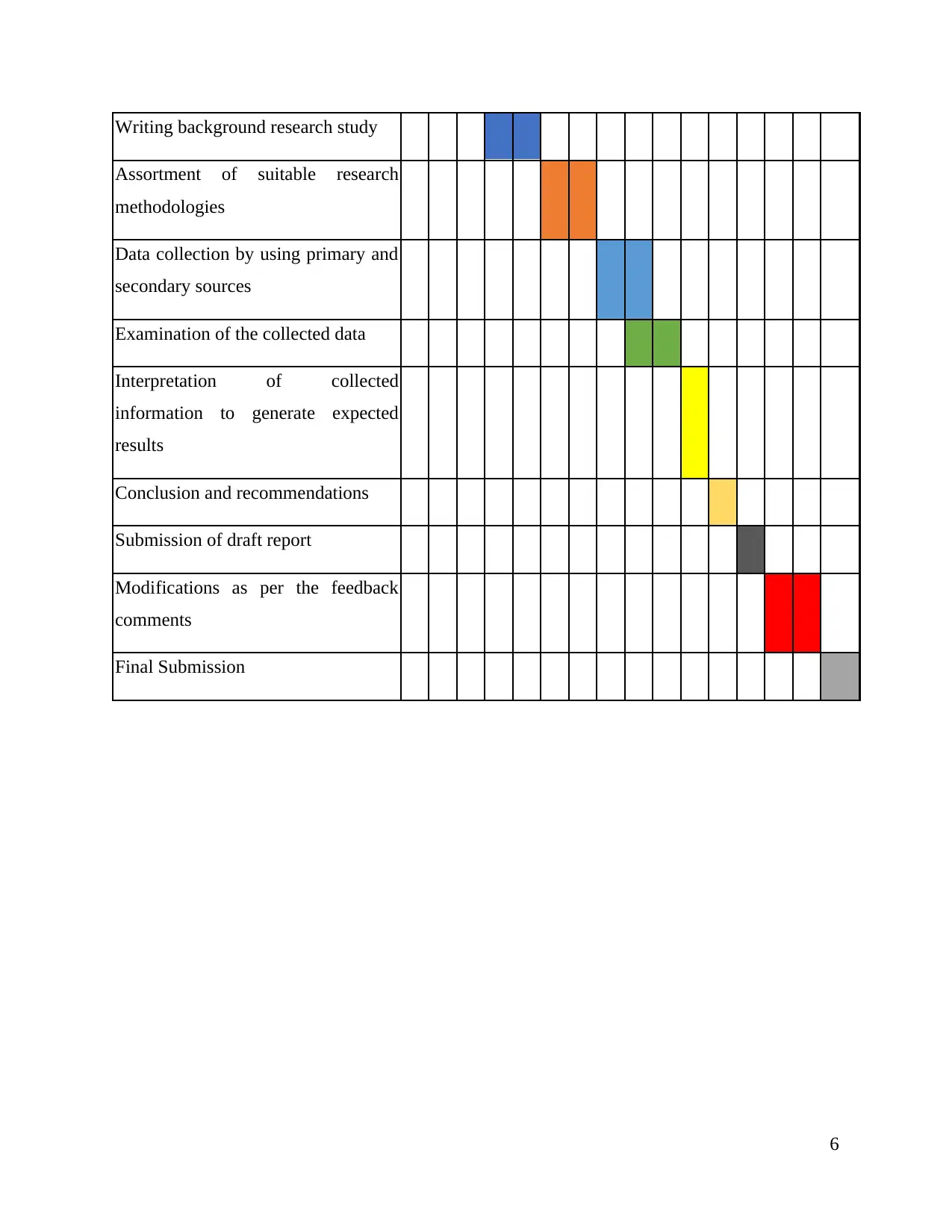
Writing background research study
Assortment of suitable research
methodologies
Data collection by using primary and
secondary sources
Examination of the collected data
Interpretation of collected
information to generate expected
results
Conclusion and recommendations
Submission of draft report
Modifications as per the feedback
comments
Final Submission
6
Assortment of suitable research
methodologies
Data collection by using primary and
secondary sources
Examination of the collected data
Interpretation of collected
information to generate expected
results
Conclusion and recommendations
Submission of draft report
Modifications as per the feedback
comments
Final Submission
6
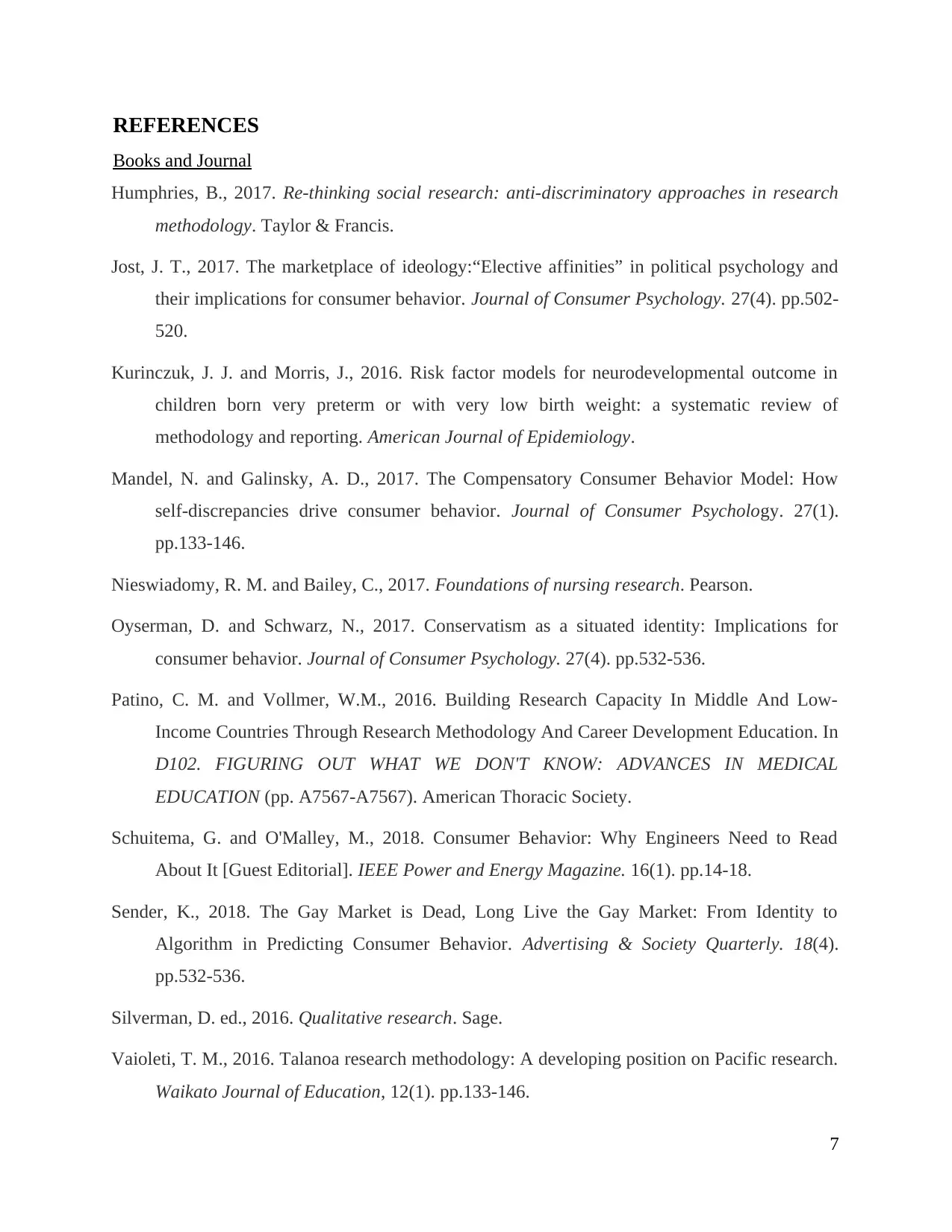
REFERENCES
Books and Journal
Humphries, B., 2017. Re-thinking social research: anti-discriminatory approaches in research
methodology. Taylor & Francis.
Jost, J. T., 2017. The marketplace of ideology:“Elective affinities” in political psychology and
their implications for consumer behavior. Journal of Consumer Psychology. 27(4). pp.502-
520.
Kurinczuk, J. J. and Morris, J., 2016. Risk factor models for neurodevelopmental outcome in
children born very preterm or with very low birth weight: a systematic review of
methodology and reporting. American Journal of Epidemiology.
Mandel, N. and Galinsky, A. D., 2017. The Compensatory Consumer Behavior Model: How
self‐discrepancies drive consumer behavior. Journal of Consumer Psychology. 27(1).
pp.133-146.
Nieswiadomy, R. M. and Bailey, C., 2017. Foundations of nursing research. Pearson.
Oyserman, D. and Schwarz, N., 2017. Conservatism as a situated identity: Implications for
consumer behavior. Journal of Consumer Psychology. 27(4). pp.532-536.
Patino, C. M. and Vollmer, W.M., 2016. Building Research Capacity In Middle And Low-
Income Countries Through Research Methodology And Career Development Education. In
D102. FIGURING OUT WHAT WE DON'T KNOW: ADVANCES IN MEDICAL
EDUCATION (pp. A7567-A7567). American Thoracic Society.
Schuitema, G. and O'Malley, M., 2018. Consumer Behavior: Why Engineers Need to Read
About It [Guest Editorial]. IEEE Power and Energy Magazine. 16(1). pp.14-18.
Sender, K., 2018. The Gay Market is Dead, Long Live the Gay Market: From Identity to
Algorithm in Predicting Consumer Behavior. Advertising & Society Quarterly. 18(4).
pp.532-536.
Silverman, D. ed., 2016. Qualitative research. Sage.
Vaioleti, T. M., 2016. Talanoa research methodology: A developing position on Pacific research.
Waikato Journal of Education, 12(1). pp.133-146.
7
Books and Journal
Humphries, B., 2017. Re-thinking social research: anti-discriminatory approaches in research
methodology. Taylor & Francis.
Jost, J. T., 2017. The marketplace of ideology:“Elective affinities” in political psychology and
their implications for consumer behavior. Journal of Consumer Psychology. 27(4). pp.502-
520.
Kurinczuk, J. J. and Morris, J., 2016. Risk factor models for neurodevelopmental outcome in
children born very preterm or with very low birth weight: a systematic review of
methodology and reporting. American Journal of Epidemiology.
Mandel, N. and Galinsky, A. D., 2017. The Compensatory Consumer Behavior Model: How
self‐discrepancies drive consumer behavior. Journal of Consumer Psychology. 27(1).
pp.133-146.
Nieswiadomy, R. M. and Bailey, C., 2017. Foundations of nursing research. Pearson.
Oyserman, D. and Schwarz, N., 2017. Conservatism as a situated identity: Implications for
consumer behavior. Journal of Consumer Psychology. 27(4). pp.532-536.
Patino, C. M. and Vollmer, W.M., 2016. Building Research Capacity In Middle And Low-
Income Countries Through Research Methodology And Career Development Education. In
D102. FIGURING OUT WHAT WE DON'T KNOW: ADVANCES IN MEDICAL
EDUCATION (pp. A7567-A7567). American Thoracic Society.
Schuitema, G. and O'Malley, M., 2018. Consumer Behavior: Why Engineers Need to Read
About It [Guest Editorial]. IEEE Power and Energy Magazine. 16(1). pp.14-18.
Sender, K., 2018. The Gay Market is Dead, Long Live the Gay Market: From Identity to
Algorithm in Predicting Consumer Behavior. Advertising & Society Quarterly. 18(4).
pp.532-536.
Silverman, D. ed., 2016. Qualitative research. Sage.
Vaioleti, T. M., 2016. Talanoa research methodology: A developing position on Pacific research.
Waikato Journal of Education, 12(1). pp.133-146.
7
⊘ This is a preview!⊘
Do you want full access?
Subscribe today to unlock all pages.

Trusted by 1+ million students worldwide
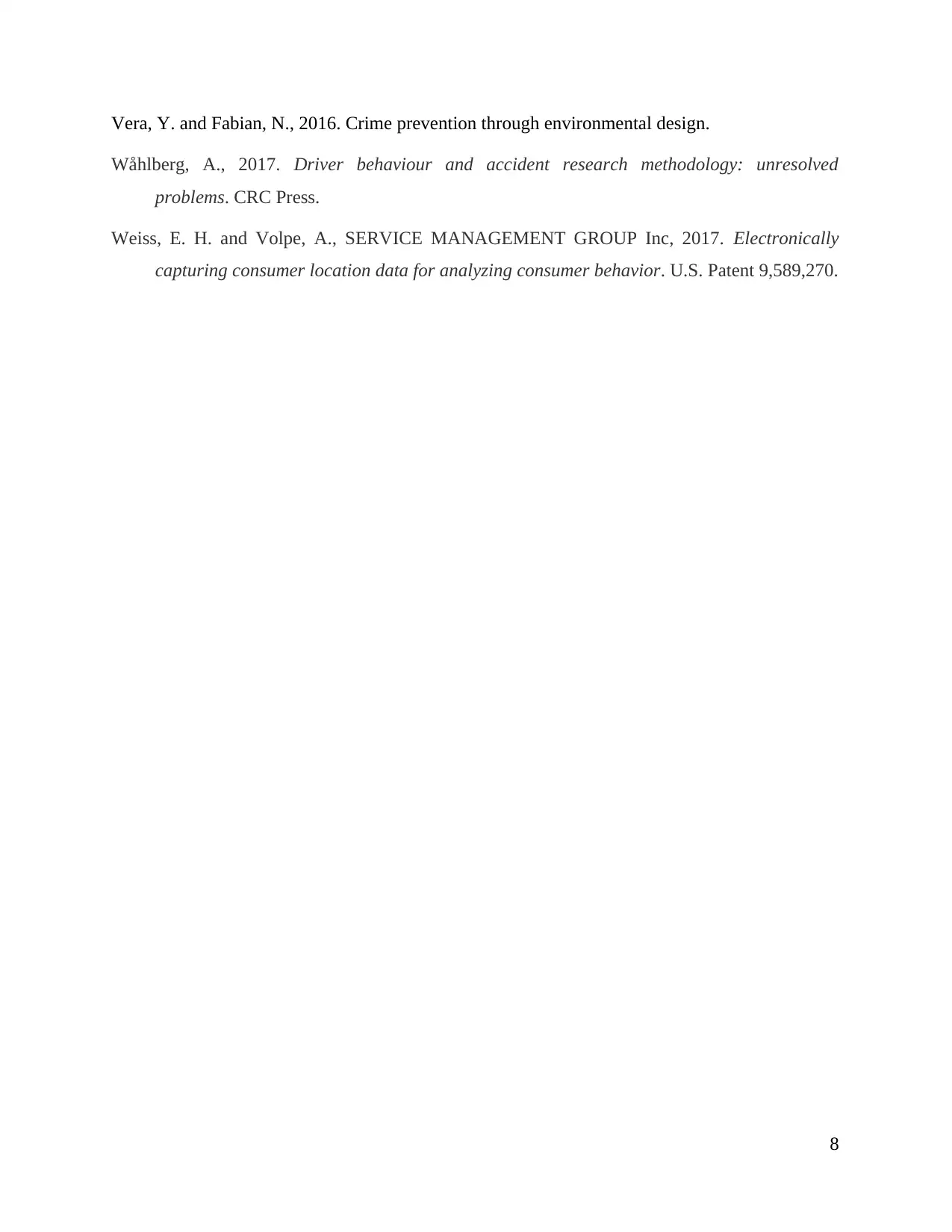
Vera, Y. and Fabian, N., 2016. Crime prevention through environmental design.
Wåhlberg, A., 2017. Driver behaviour and accident research methodology: unresolved
problems. CRC Press.
Weiss, E. H. and Volpe, A., SERVICE MANAGEMENT GROUP Inc, 2017. Electronically
capturing consumer location data for analyzing consumer behavior. U.S. Patent 9,589,270.
8
Wåhlberg, A., 2017. Driver behaviour and accident research methodology: unresolved
problems. CRC Press.
Weiss, E. H. and Volpe, A., SERVICE MANAGEMENT GROUP Inc, 2017. Electronically
capturing consumer location data for analyzing consumer behavior. U.S. Patent 9,589,270.
8
1 out of 10
Related Documents
Your All-in-One AI-Powered Toolkit for Academic Success.
+13062052269
info@desklib.com
Available 24*7 on WhatsApp / Email
![[object Object]](/_next/static/media/star-bottom.7253800d.svg)
Unlock your academic potential
Copyright © 2020–2025 A2Z Services. All Rights Reserved. Developed and managed by ZUCOL.




